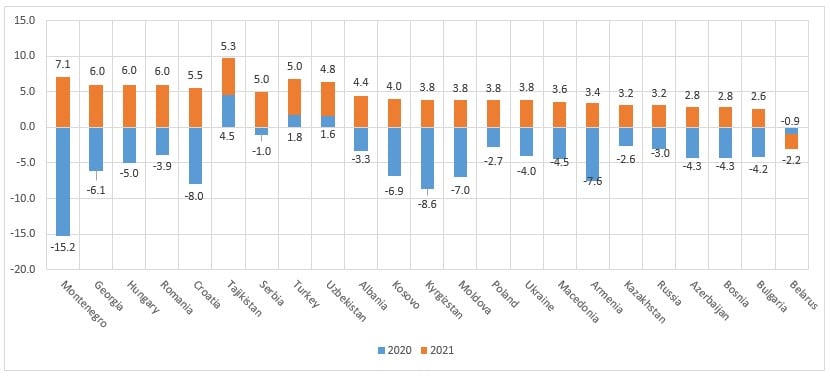Irakli Gharibashvili: “Take a look at the countries of the region and trends in Europe, there are not many places with such a growth.”
Verdict: FactCheck concludes that Irakli Gharibashvili’s statement is HALF TRUE.
Resume:
According to the World Bank’s data, 23 countries from Eastern Europe, the Middle East, Central Asia, the Balkan Peninsula and the Caucasus comprise Georgia’s region. Based on the forecast data of June 2021, Georgia ranks 2nd in the region in terms of its economic growth rate with only Montenegro having better figures. However, the base effect caused by last year’s economic downturn is not the same for every country. It is easier for those countries which experienced a sharper economic decline last year to achieve high economic growth as compared to other countries whose economy shrank insignificantly or even increased.
Of note is that in the case of Georgia, high economic growth is stipulated by the base effect since stringent restrictions resulted in a 6.1% decline in the economy in 2020. Of the 23 countries, only six had worse economic growth figures as compared to Georgia – Montenegro (-15.2%), Croatia (-8.0%), Kosovo (-6.9%), Kyrgyzstan (-8.6%), Moldova (-7.0%) and Armenia (-7.6%). Romania and Hungary, which have higher economic growth rates this year as compared to Georgia, had their economies contracted last year by 3.9% and 5%, respectively. Of additional note is that the economies of Tajikistan, Turkey and Uzbekistan, which currently have 5.3%, 5.0% and 4.8% growth rates, respectively, had their economies grow by 4.5%, 1.8% and 1.7%, also respectively in 2020 instead of a contraction. Serbia’s current economic growth is 5.0% and its economy decreased by only 1% in 2020.
Given the aforementioned factors, the Prime Minister’s statement is partially accurate but significant details, which are necessary in order to have a comprehensive understanding, are missing. Therefore, FactCheck concludes that Irakli Gharibashvili’s statement is HALF TRUE.
FactCheck does not agree to the Prime Minister’ opinion that the current economic growth is an outcome of the government’s right steps. However, discussing this issue goes beyond the scope of this article and, therefore, this part of the statement has not been taken into account whilst making the verdict.
Analysis
On 2 August 2021, at the session of the Government of Georgia, the Georgian Prime Minister, Irakli Gharibashvili, stated:
“Take a look at the neighbour countries and, generally, at the trends of the region. There are not many places with such a growth. Our country does indeed have an unprecedented growth. Economic growth and economic recovery in the country is happening at a rapid pace. I would like to remind our people that as a result of the right steps that we have made, there is a rapid economic recovery in the country.”
FactCheck decided to verify accuracy of the statement.
According to the World Bank’s data, 23 countries from Eastern Europe, the Middle East, Central Asia, the Balkan Peninsula and the Caucasus comprise Georgia’s region.
Graph 1: Countries of Georgia’s Region in Terms of GDP Growth (First Six Months of 2021)

Source: World Bank
According to Graph 1, Georgia is ranked 2th -4th in terms of its economic growth rate (8%) among the 23 countries and is only outperformed by Montenegro. However, the base effect caused by the last year’s economic downturn is not the same for every country. It is easier for those countries which experienced a
Of note is that in the case of Georgia, high economic growth is stipulated by the base effect since stringent restrictions resulted in a 6.1% decline in the economy in 2020. Of the 23 countries, only six had worse economic growth figures in 2020 as compared to Georgia – Montenegro (-15.2%), Croatia (-8.0%), Kosovo (-6.9%), Kyrgyzstan (-8.6%), Moldova (-7.0%) and Armenia (-7.6%). Of additional note is that the economies of Tajikistan, Turkey and Uzbekistan, which currently have 5.3%, 5.0% and 4.8% growth rates, respectively, had their economies grow by 4.5%, 1.8% and 1.7%, also respectively in 2020 instead of a contraction. Serbia’s current economic growth is 5.0% and its economy decreased by only 1% in 2020.
Georgia’s example can be used to better illustrate all of these. In order to offset the 6.1% economic decline in 2021, Georgia’s economy needs to have a 7.5-8% economic growth rate in 2021. Therefore, if the WB 6% forecast comes true, the economy of Georgia will actually contract by a small margin compared to Y2019.
Editor's Note: In the original version of the article, a few inaccuracies were made in the calculation of several numbers, which did not have a significant impact on either the content of the article or the verdict of the statement. The error was corrected after the inaccuracies were detected.








